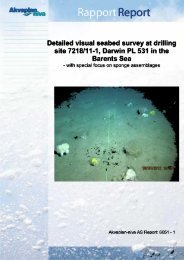A study of the priority substances of the Water Framework Directive ...
A study of the priority substances of the Water Framework Directive ...
A study of the priority substances of the Water Framework Directive ...
Create successful ePaper yourself
Turn your PDF publications into a flip-book with our unique Google optimized e-Paper software.
..:::::::::: arsenic<br />
..:::86<br />
d Arsenic<br />
� Arsenic is a carcinogen and it bioaccumulates.<br />
� Main use has been wood preservation.<br />
� There are few data on marine pollution <strong>of</strong><br />
arsenic.<br />
� There is a need for screening <strong>of</strong> arsenic.<br />
Production and use<br />
Arsenic has mainly been used as a wood preservative,<br />
but this use is now prohibited.<br />
Emissions, discharges,<br />
distribution and hot-spots<br />
Norwegian emissions in 2002 are estimated to 7<br />
tons, down from more than 350 tons in 1985<br />
via 14 tons in 1995. Discharges to water have<br />
increased from about 1 ton in 1995 to 1,4 tons<br />
in 2002.<br />
Monitoring<br />
Monitoring <strong>of</strong> arsenic has been part <strong>of</strong> RID<br />
(time trend exists). Arsenic has also been investigated<br />
in a few o<strong>the</strong>r studies (see references).<br />
Marine sediment<br />
Increased levels are found in<br />
Kristiansandsfjorden and Ballangsfjorden. No<br />
effects are known.<br />
Fresh water<br />
Several rivers have been monitored on a yearly<br />
basis since 1990. Arsenic levels have been generally<br />
low.<br />
Fresh water sediment<br />
Concentrations <strong>of</strong> arsenic are generally low in<br />
lakes, standards for drinking water are being<br />
kept.<br />
Fresh water biota<br />
Low levels <strong>of</strong> arsenic are found in fish.<br />
Hotspots<br />
Hotspots for arsenic are in particular manufacturing<br />
sites for preservation <strong>of</strong> wood.<br />
Need for fur<strong>the</strong>r screening and monitoring<br />
There are few data on arsenic concentrations in<br />
<strong>the</strong> environment. A thorough screening should<br />
be made in order to estimate <strong>the</strong> effectiveness <strong>of</strong><br />
<strong>the</strong> policies and measures taken to reduce emissions.<br />
A <strong>study</strong> <strong>of</strong> <strong>the</strong> <strong>priority</strong> <strong>substances</strong> <strong>of</strong> <strong>the</strong> <strong>Water</strong> <strong>Framework</strong> <strong>Directive</strong><br />
TA-2140/2005<br />
FACTS<br />
Arsenic is a human carcinogen, and some arsenic<br />
compounds are highly toxic. Arsenic accumulates in<br />
aquatic organisms and organic arsenic compounds<br />
can bioaccumulate.<br />
Localities for fur<strong>the</strong>r screening and monitoring<br />
Arsenic should be screened in marine sediments<br />
and in marine biota. It should also be screened<br />
in fresh water biota.<br />
Analysis<br />
There are several well-established techniques for<br />
determination <strong>of</strong> As. Several companies <strong>of</strong>fer<br />
this service in Norway and Europe. The most<br />
frequently techniques are Inductively coupled<br />
plasma mass spectrometry (ICP-MS), Inductively<br />
coupled Plasma Atomic Emission Spectroscopy<br />
(ICP-AES), Graphite Furnace Atomic<br />
Absorption Spectroscopy (GF-AAS) and Flame<br />
Atomic Absorption Spectroscopy (F-AAS).<br />
Methods<br />
<strong>Water</strong> samples are acidified with 1-10% nitric<br />
acid.<br />
For analysis <strong>of</strong> solid samples, <strong>the</strong> methods are<br />
based on digestion with nitric acid / hydrogen<br />
peroxide in sealed containers using microwave<br />
system.<br />
Synergy with o<strong>the</strong>r analyses<br />
The sample digestion method used for determination<br />
<strong>of</strong> arsenic can also be used for determination<br />
<strong>of</strong> Pb, Hg, Ni, Zn, Cr, Cu and Ni.<br />
References<br />
� Nasjonalt folkehelseinstitutt: Miljø og helse -<br />
en forskningsbasert kunnskapsbase. Revisjon<br />
2003. Rapport 2003:9.<br />
� Miljøstatus: Arsen<br />
� SFT Tiltaksplan 1995-2002<br />
� Fylkesvise tiltaksplaner for forurensede sedimenter,<br />
Rapport fra fase 1 for Farsundsområdet<br />
med Lyngdalsfjorden, Vest-Agder.<br />
� Riverine inputs and direct discharges to<br />
Norwegian coastal waters - 2003. Part B: Data<br />
report.

















